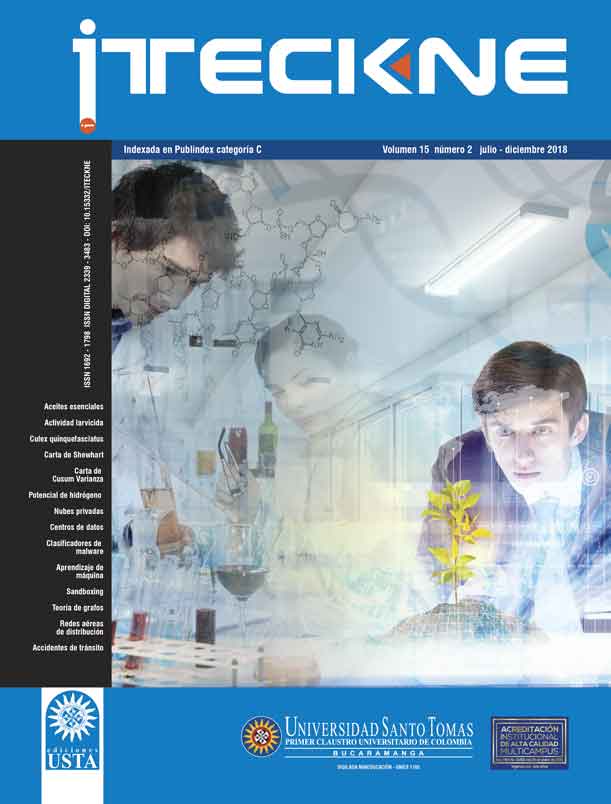Planeación óptima de redes aéreas de distribución basada en teoría de grafos
DOI:
https://doi.org/10.15332/iteckne.v15i2.2073Palabras clave:
Optimización, planificación óptima, redes de distribución eléctrica, árbol mínimo de Steiner, transformadoresResumen
Este trabajo presenta un modelo para optimizar los recursos utilizados en la planeación de una red de distribución aérea, la cual permite el despliegue de los transformadores considerando su cobertura y su capacidad. Muestra un modelo de enrutamiento de la red de media tensión basado en minimun Steiner tree para encontrar la mejor ruta en una zona georreferenciada. La planeación se realiza sobre un escenario georreferenciado con datos de la plataforma OpenStreetMap, con el fin de que la localización de los transformadores y la topología de la red sean reales. Los valores obtenidos muestran un punto de partida para que las empresas de distribución eléctrica establezcan planes de trabajo para la expansión y planificación de la red eléctrica de distribución, considerando la variabilidad a la que se presenta la demanda.
Descargas
Citas
K. Lin, X. Jing, Z. Hengjun, and W. Beibei, “Planning Method for Distribution Networks Based on Load Growth Characteristics of the Industry,” CICED, pp. 10-13, 2016.
J. Fletcher, T. Fernando, H. Iu, M. Reynolds, and S. Fani, “A case study on optimizing an electrical distribution network using a genetic algorithm,” 2015 IEEE 24th Int. Symp. Ind. Electron, pp. 20-25, 2015.
G. A. Jiménez-Estevez, L. S. Vargas, and R. Palma-Behnke, “An evolutionary approach for the greenfield planning problem in distribution networks,” IEEE Int. Conf. Neural Networks - Conf. Proc., pp. 1744-1749, 2007.
V. Dumbrava, P. Ulmeanu, P. Duquenne, C. Lazaroiu, and M. Scutariu, “Expansion planning of distribution networks by heuristic algorithms,” Proc. Univ. Power Eng. Conf., 2010.
E. G. Carrano, F. G. Guimarães, R. H. C. Takahashi, O. M. Neto, and F. Campelo, “Electric distribution network expansion under load-evolution uncertainty using an immune system inspired algorithm,” IEEE Trans. Power Syst., vol. 22, no. 2, pp. 851-861, 2007.
D. Deka, M. Chertkov, and S. Backhaus, “Structure Learning in Power Distribution Networks,” IEEE Trans. Control Netw. Syst., vol. 5870, no. c, pp. 1-1, 2017.
R. M. Capelini et al., “Methodology for Fast Location in Overhead Distribution Networks by Application of Temporary Georeferenced Fault Indicators,” 2016 IEEE Int. Conf. High Volt. Eng. Appl., pp. 6-9, 2016.
J. F. Gómez et al., “Ant colony system algorithm for the planning of primary distribution circuits,” IEEE Trans. Power Syst., vol. 19, no. 2, pp. 996-1004, 2004.
K. E. Antoniadou-Plytaria, N. C. Koutsoukis, E. S. Sergaki, and P. S. Georgilakis, “Multiyear power distribution planning considering voltage regulator placement,” IET Conf. Publ., vol. 2016, no. CP711, pp. 1-6, 2016.
A. Samui, S. Singh, T. Ghose, and S. R. Samantaray, “A Direct Approach to Optimal Feeder Routing for Radial Distribution System,” IEEE Trans. Power Deliv., vol. 27, no. 1, pp. 253-260, 2012.
V. F. Martins and C. L. T. Borges, “Active Distribution Network Integrated Planning Incorporating Distributed Generation and Load Response Uncertainties,” IEEE Trans. Power Syst., vol. 26, no. 4, pp. 2164-2172, 2011.
M. Campaña, E. Inga, and R. Hincapié, “Optimal placement of universal data aggregation points for smart electric metering based on hybrid wireless,” CEUR Workshop Proc., vol. 1950, pp. 6-9, 2017.
R. Wang et al., “A Graph Theory Based Energy Routing Algorithm in Energy Local Area Network,” IEEE Trans. Ind. INFORMATICS, vol. 13, no. 6, pp. 3275-3285, 2017.
Y. Chen, S. Wang, J. Yu, W. Li, X. Shi, and W. Yang, “Optimal Weighted Voronoi Diagram Method of Distribution Network Planning Considering City Planning Coordination Factors,” 2017 4th Int. Conf. Syst. Informatics, no. Icsai, pp. 335-340, 2017.
H. Chunguang et al., “Distribution network island separation with distributed generation (DG) based on dynamic planning,” Proc. 2017 IEEE 2nd Adv. Inf. Technol. Electron. Autom. Control Conf. IAEAC 2017, pp. 1767-1771, 2017.
J. Lichtinghagen, M. Sieberichs, A. Moser, and A. Kübler, “Medium voltage network planning considering the current network and geographical restrictions,” 2017 6th Int. Conf. Clean Electr. Power Renew. Energy Resour. Impact, ICCEP 2017, pp. 689-693, 2017.
E. Díaz-Dorado, J. Cidrás, and E. Míguez, “Application of evolutionary algorithms for the planning of urban distribution networks of medium voltage,” IEEE Trans. Power Syst., vol. 17, no. 3, pp. 879-884, 2002.
A. Peralta, E. Inga, and R. Hincapié, “Optimal Scalability of FiWi Networks Based on Multistage Stochastic Programming and Policies,” J. Opt. Commun. Netw., vol. 9, no. 12, p. 1172, 2017.
E. Inga, S. Céspedes, R. Hincapié, and A. Cárdenas, “Scalable Route Map for Advanced Metering Infrastructure Based on Optimal Routing of Wireless Heterogeneous Networks,” IEEE Wirel. Commun., vol. 24, no. April, pp. 1-8, 2017.
J. Naor, D. Panigrahi, and M. Singh, “Online node-weighted Steiner tree and related problems,” Proc. - Annu. IEEE Symp. Found. Comput. Sci. FOCS, pp. 210–219, 2011.
X. Han, J. Liu, D. Liu, Q. Liao, J. Hu, and Y. Yang, “Distribution network planning study with distributed generation based on Steiner tree model,” 2014 IEEE PES Asia-Pacific Power Energy Eng. Conf., vol. 1, pp. 1-5, 2014.
L. P. Zhang, Z. X. Yang, Q. Y. He, and D. M. Cai, “Immune algorithm for minimal Steiner tree problems,” Int. Conf. Adv. Mechatron. Syst. ICAMechS, vol. 2017, Decem, pp. 110-115, 2018.
C. Wang, H. Liang, X. Geng, and M. Zhu, “Multi-sensor fusion method using kalman filter to improve localization accuracy based on android smart phone,” 2014 IEEE Int. Conf. Veh. Electron. Safety, ICVES 2014, pp. 180-184, 2015.
Descargas
Publicado
Cómo citar
Número
Sección
Licencia
La revista ITECKNE se encuentra registrada bajo una licencia de Creative Commons Reconocimiento-NoComercial 4.0 Internacional Por lo tanto, esta obra se puede reproducir, distribuir y comunicar públicamente, siempre que se reconozca el nombre de los autores y a la Universidad Santo Tomás. Se permite citar, adaptar, transformar, autoarchivar, republicar y crear a partir del material, siempre que se reconozca adecuadamente la autoría, se proporcione un enlace a la obra original y se indique si se han realizado cambios.
La Revista ITECKNE no retiene los derechos sobre las obras publicadas y los contenidos son responsabilidad exclusiva de los autores, quienes conservan sus derechos morales, intelectuales, de privacidad y publicidad. Sin embargo esta facultada para editar, publicar, reproducir y distribuir tanto en medios impresos como digitales, además de incluir el artículo en índices internacionales y/o bases de datos, de igual manera, se faculta a la editorial para utilizar las imágenes, tablas y/o cualquier material gráfico presentado en el artículo para el diseño de carátulas o posters de la misma revista.













